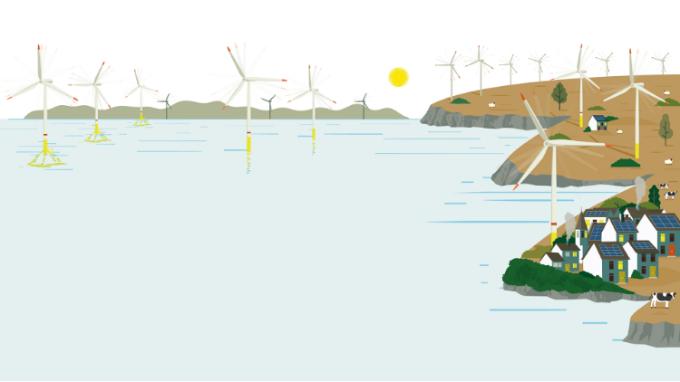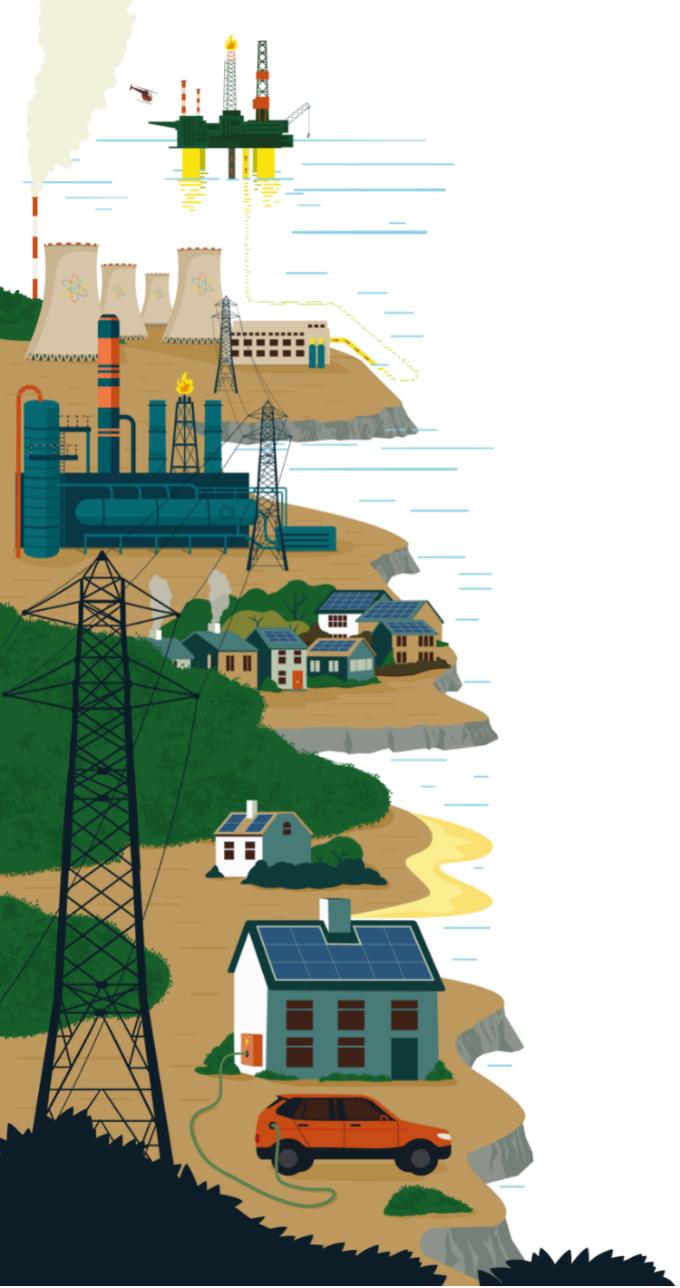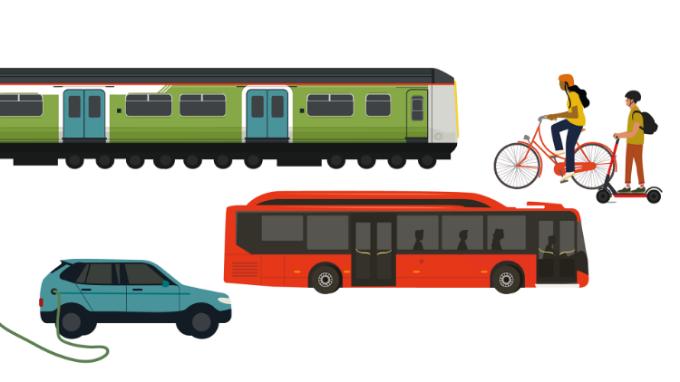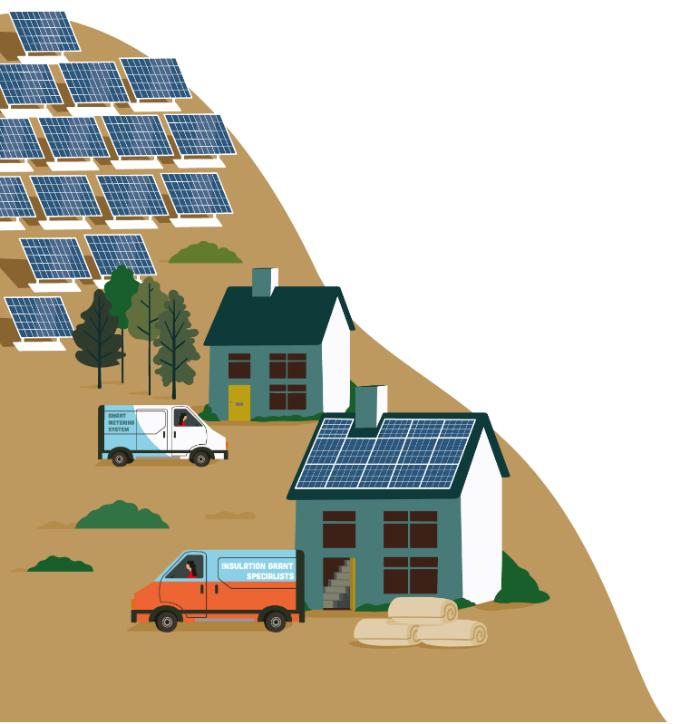Earth, Wind and Fire: Can UK Power Hit Net-Zero?
Illustrations by Tracy Worrall
11 min read
In order to meet our emission goals by 2050, the UK must move away from using coal and gas-fired power to electricity generated from renewables, nuclear power and technologies such as carbon capture. Georgina Bailey looks at what steps the government must take now to stay on the Climate Change Committee’s ‘balanced pathway’ to net-zero.
The UK has made great strides in decarbonising its electricity over the last 30 years, with carbon emissions from the power sector reducing by 62 per cent since 1990.
A large part of this has been down to the near-complete phase out of coal, and improved energy efficiency of homes and appliances, meaning demand is reduced.
Currently, about a third of the UK’s energy is used for electricity, the other two-thirds being transport (primarily oil) and heating (primarily gas).
However, in the route to net-zero by 2050 envisaged by the Climate Change Committee (CCC), demand for electricity in the UK will double, as both transport and heating for buildings becomes increasingly electrified.
“Not only do we need to make the electricity supply greener, but also in the future we will need to expand the total electricity supply in order to power our electric cars and provide the energy for our electric heat pumps,” says Professor Rob Gross, director of the UK Energy Research Centre.
The good news is that while the pandemic saw a reduction in energy production and demand, 2020 was also the first year in the UK’s history where renewable sources of energy outstripped fossil fuels.
According to Energy Trend reports from the Department for Business, Energy and Industrial Strategy (BEIS), fossil fuels generated 38.5 per cent of the country’s 313TWh of electricity in 2020, while renewable sources provided 43 per cent of the UK’s energy (134TWh), with wind providing more than half of that. Nuclear generated just 16 per cent (a decrease of 11 per cent compared to 2019, partly down to outages at multiple plants).
However, there is still some way to go to meet the CCC’s “balanced pathway” to net-zero by 2050, which would see anywhere between 75 and 90 per cent of the UK’s energy needs met by low-cost renewables. So what does the government have to do now to meet its net-zero goals?

Wind
Current capacity: 13.7GW onshore wind, 10.41GW offshore wind. From 2015 to 2019, an average of 31.14 per cent of capacity was produced, but 2020 saw record levels of generation from wind, particularly offshore, due to gale-force conditions caused by storms Ciara, Dennis and Jorge.
Government’s 2030 goals: 40GW power produced from offshore wind (including 1GW power from floating wind).
CCC 2050 Balanced Pathway: 95GW offshore wind, with an average build rate of 3GW per year between 2030 and 2050. Doubling onshore wind capacity to 25-30GW.
Opportunities: The government’s 40GW by 2030 offshore wind target was widely lauded when it was announced last November – and many in the sector think it is achievable. “The backbone of the UK energy system is rapidly becoming, and will be, offshore wind,” says Nathan Bennett, head of public affairs at RenewableUK. “We’re already world leaders in the development of it.”
In the last decade, the cost of offshore wind has fallen from £150/MWh to £45/MWh (cheaper than gas at £50/MWh) and the CCC says the existing seabed lease the government has agreed with the Crown Estate in England and Wales should be sufficient for the 2030 goal. UK experience in oil and gas should stand development of floating wind farm bases in good stead.
Last year, the UK government dropped its opposition to onshore wind, and it will be included in the new auction of Contracts for Difference (the government’s main mechanism for supporting renewable energy – protecting investors from volatility in the market price for energy) later in 2021.
The backbone of the UK energy system is rapidly becoming, and will be, offshore wind
A YouGov survey for RenewableUK in May found that 70 per cent of people supported the building of onshore wind farms, with no difference between those living within five miles of a wind farm and those living further away. RenewableUK has called for a 30GW target for onshore wind by 2030. In concert with the offshore wind strategy, they say this will increase investor confidence and help secure the UK as a world leader in wind power.
The shelf-life of an onshore wind farm is 15 to 20 years, so the repowering of existing wind farms with more efficient and powerful modern turbines will mean an increase in capacity – for example, when Caton Moor wind farm in Lancashire was repowered, replacing 10 turbines with eight modern ones, output from the site was increased seven fold to 47 million units of electricity per annum.
Challenges: Renewable capacity growth began to slow in 2019 and has continued to slow since. An additional 20GW of offshore wind will need to be commissioned in the 2020s to hit the government’s target.
One of the major challenges for offshore wind is the connection to land and the grid – a lack of co-ordination between different offshore transmission owners, offshore wind developers and operators has meant that connection routes have been planned independently, reducing overall efficiency and disrupting coastal communities. A review by BEIS into this is expected to report by the end of the year. Upgrades to ports will also be needed.
The CCC, Bennett and Gross all believe the government’s 2030 ambitious wind goals must be matched by long-term commitments to Contracts for Difference.
“There’s an international pool of prospective investment in renewables, but lots of countries are competing for that investment,” Gross says. “Contracts for Difference have been very successful, because they offer a very low-risk environment. The government is already considering, in its white paper consultation earlier in the year, whether it should change the Contracts for Difference because [of concerns] they distort the market. [The government needs] to proceed very cautiously with that, because it might make the investment conditions less attractive, and you can’t do any of this unless you attract the investment.”
Some also believe that targets beyond 2030 should be established, to provide long-term certainty for investors.
In particular, the development of floating offshore wind farms is an area of great potential for the UK. There is currently no global leader in floating wind farms (which provide deep-water alternatives as they do not have to be rooted in the seabed), and the UK’s current 1GW target by 2030 is more than 15 times the current volumes worldwide.
RenewableUK says doubling that target to 2GW would play an important diplomatic role in encouraging further global investment (particularly given COP26 this year), as well as accelerating cost reduction. Key hubs would include Scotland, Wales and the south-west of England. Floating wind is also less disruptive to wildlife.
To reach 30GW deployment of onshore wind, an additional 3,300km2 of land could be needed.
Nuclear
Current capacity: Nuclear has consistently provided about 20 per cent of the UK’s electricity (capacity of 9GW across 15 reactors). However, 8GW of this capacity is due to be retired in the 2020s , meaning nuclear would then provide two to three per cent.
CCC 2050 Balanced Pathway: 10GW capacity.
Opportunities: Nuclear is a low-carbon energy source, and provides a reliable baseload of energy when renewables cannot. Most models to net-zero include a role for nuclear, and successive UK governments have been supportive of new nuclear power in the UK.
Hinkley Point C is currently under construction in Somerset, and expected to be operational in 2026. The government’s ‘Ten Point Plan for a Green Industrial Revolution’ commits to providing development funding for large-scale new nuclear projects, subject to value-for-money. The government is currently in discussions with EDF and CGN over a planned new reactor at Sizewell, to reportedly come online in 2031.
The Ten Point Plan also includes a commitment of up to £385m for an Advanced Nuclear Fund, enabling investment of up to £215m for small modular reactors (SMRs) and up to £300m in private sector match funding.
A consortium led by Rolls-Royce intends to conclude the first phase of concept design for SMRs by the end of the year, and globally there are currently more than 40 designs at various stages of development.
The government also committed up to £170m for a research and development programme on advanced modular reactors (AMRs), and aims to have the first SMRs and AMR demonstrator deployed in the UK by the early 2030s.
Nuclear power has really struggled to find finance, and is now looking expensive compared to renewables
Challenges: No new nuclear power station has been built in the UK since 1995, and progress on several sites has repeatedly stalled. Gross explains: “Individual renewable schemes, even big schemes like offshore wind farms, are relatively small and relatively cheap compared to a nuclear power station, and they’re also relatively quick to build. So nuclear power has really struggled to find finance, and is now looking expensive compared to renewables.”
High upfront costs for nuclear means the sector is dependent on government intervention and support. The involvement of CGN (a Chinese firm) has raised some concerns about security.
The Fukushima meltdown in 2011 increased global scepticism of nuclear power, and questions remain over disposal of nuclear waste.

Gas Carbon Capture & Storage (CCS) and Bioenergy Carbon Capture & Storage (BECCS)
CCC 2050 Balanced Pathway: 15GW gas and CCS, 5GW bioenergy with CCS.
Opportunities: Gas has been the dominant component of the UK’s energy mix since the 1990s, generating 36.5 per cent of the UK’s total energy in 2020. Generation from bioenergy has remained steady at 11.8 per cent.
The variability of renewable production means the CCC Balanced Pathway envisages a role for both gas CCS and BECCS in a net-zero future, providing between seven and 15 per cent of the UK’s electricity by 2050. The UK is well-placed to store CO2 on a large scale, with analysis by the CCC finding that storage in the North Sea could “support 50GW of gas CCS plant running all year, for 500 years”.
The government has committed £1bn in funding by 2025 to developing CCS technology for power production and industry, with two clusters to be operational by the mid-2020s and a further two by 2030. Drax power plant in North Yorkshire is currently trialling BECCS.
Challenges: The usefulness of CCS is dependent on it successfully capturing between 90 and 95 per cent of carbon, and it has a higher cost than renewables (although it is competitive with nuclear). If BECCS and gas CCS systems were to be operational only part of the time (when renewable output was low), then the start-up and shut-down process would mean more carbon was released.
The CCC warns “the development of BECCS is contingent on sourcing sustainable biomass, given concerns over the associated lifecycle emissions,” while Gross says the development and roll out of CCS will require an interventionist approach from government, with clear co-ordination and planning.
Other sources: Hydrogen and Solar
The role of hydrogen in the future electricity mix is a controversial topic, with questions over blue or green hydrogen (only the latter is low-carbon), storage and transportation. While both the CCC and the government envisage a role, the publication of the government’s Hydrogen Strategy has been delayed (it was originally expected in early 2021), and the CCC has said hydrogen is not a “silver bullet”. The government aims to see 5GW of low-carbon hydrogen production by 2030.
In 2020, solar produced four per cent of the UK’s electricity, but the CCC envisages that by 2050, it should be 10 to 15 per cent. This would require building an additional 3GW capacity per year. In 2020, just 217MW of additional solar capacity was installed (some delays were caused by the pandemic).
If we’re going to build more solar and decentralised renewables, we need to make sure we can use that in local networks
The UK’s solar PV is a mix of solar farms and roof installations, and while the UK government has become more pro-solar farm recently, Gross says ending the feed-in tariff scheme, which supported small-scale generation, in 2019 will have a detrimental effect on small-scale solar PV installation. He believes a reduced subsidy is needed, as well as work with consumers.
“If we’re going to build more solar and decentralised renewables, we need to make sure we can use that in local networks,” Gross says. “That needs smart meters to get rolled out and it needs to provide the wherewithal for people to trade energy amongst themselves... It’s also about whether the communities and individuals really want to embrace that opportunity.”
Currently, large-solar requires 290km2 of land, but the CCC says “maximising the potential of solar generation might entail using an additional 1,500 km2”. UK weather patterns also mean more solar is produced in the summer when less energy is needed, so storage or other utilisation, such as producing hydrogen, will need to be developed.
